路由交换-作业12 15.6.2lab
当前进度 1.0
更新地址: https://blog.dayi.ink/?p=52 更新地址: https://type.dayiyi.top/index.php
【dayi的大键盘】新的博客:https://blog.dayi.ink ,欢迎来体验新的阅读。
更新中修改的内容
本文考虑写作时间的特殊性,如有问题请直接在文章末尾留言,相互提醒下,可能不再更新(写到凌晨1点多,明天还有特别多特别多事,估计来不及改了
0x00 准备文件
- word文件
- oppos,要自己画)
- 步骤文件可以去末尾下
0x01 打开文件
- 没有这个步骤
0x02 准备文件
- 4321 * 2
- 2960 * 2
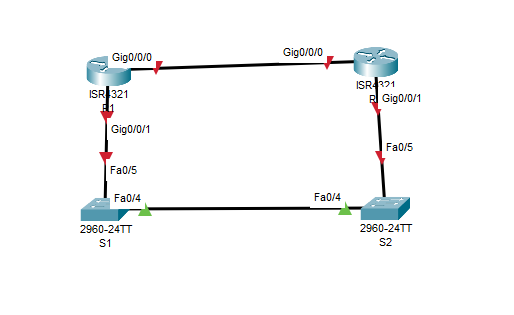
记得注意接口。
0x10 第 *1* 部分: 建立网络并配置设备的基本设置
0x11 步骤 1 : 建立如拓扑图所示的网络。
如上图所示
0x12 步骤 *2* : 为每台路由器配置基本设置。
a. 为路由器分配一个设备名称。
打开**配置窗口**
b. 要防止路由器尝试将错误输入的命令视为主机名, 则禁用 DNS 查找。
c. 指定 *class* 作为特权 EXEC 加密密码。
d. 指定 *cisco* 作为控制台密码并启用登录。
e. 指定 *cisco* 作为 VTY 密码并启用登录。
f. 加密明文密码。
g. 创建一个向访问设备者发出警告的标语:未经授权,禁止访问。
h. 将运行配置保存到启动配置文件中。
R1
no
Router>en
Router#conf t
Router(config)#hostname R1
R1(config)#no ip domain lookup
R1(config)#enable secret class
R1(config)#line console 0
R1(config-line)#password cisco
R1(config-line)#login
R1(config-line)#line vty 0 4
R1(config-line)#password cisco
R1(config-line)#login
R1(config-line)#service password-encryption
R1(config)#banner motd $ Authorized Users Only! $
R1(config)#exit
R1#copy running-config startup-config R2
Router>en
Router#conf t
Router(config)#hostname R2
R2(config)#no ip domain lookup
R2(config)#enable secret class
R2(config)#line console 0
R2(config-line)#password cisco
R2(config-line)#login
R2(config-line)#line vty 0 4
R2(config-line)#password cisco
R2(config-line)#login
R2(config-line)#service password-encryption
R2(config)#banner motd $ Authorized Users Only! $
R2(config)#exit
R2#
%SYS-5-CONFIG_I: Configured from console by console
copy running-config startup-config
Destination filename [startup-config]?
Building configuration...
[OK]
R2#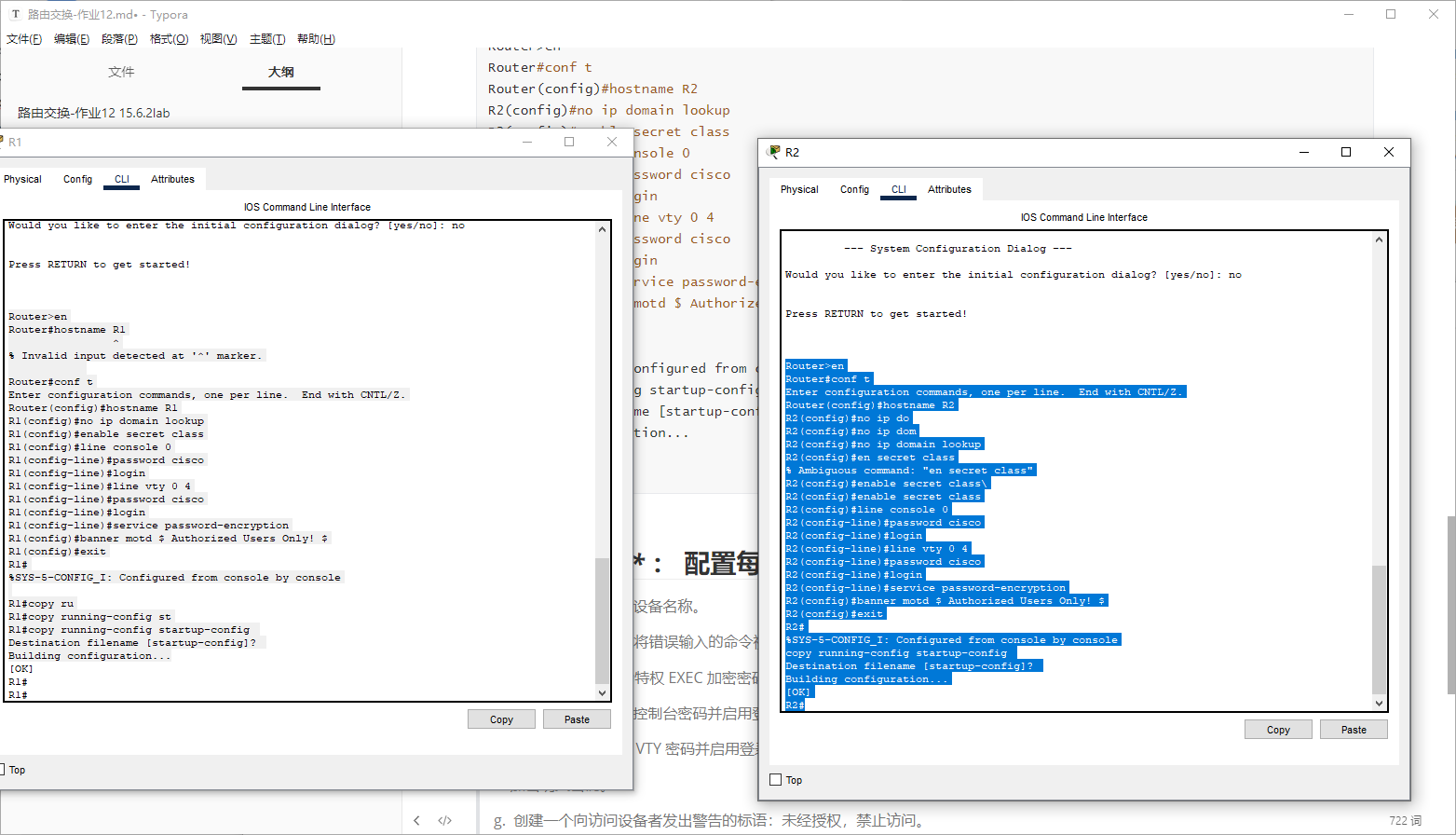
0x13 步骤 *3* : 配置每台交换机的基本设置。
a. 给交换机分配一个设备名称。
b. 要防止路由器尝试将错误输入的命令视为主机名, 则禁用 DNS 查找。
c. 指定 *class* 作为特权 EXEC 加密密码。
d. 指定 *cisco* 作为控制台密码并启用登录。
e. 指定 *cisco* 作为 VTY 密码并启用登录。
f. 加密明文密码。
g. 创建一个向访问设备者发出警告的标语:未经授权,禁止访问。
h. 关闭所有不使用的接口。
i. 将运行配置保存到启动配置文件中。 问题:
S1
Switch>en
Switch#conf t
Enter configuration commands, one per line. End with CNTL/Z.
Switch(config)#hostname S1
S1(config)#no ip domain-lookup
S1(config)#enable secret class
S1(config)#line console 0
S1(config-line)#password cisco
S1(config-line)#login
S1(config-line)#line vty 0 15
S1(config-line)#password cisco
S1(config-line)#login
S1(config-line)#service password-encryption
S1(config)#banner motd $ Authorized Users Only! $
S1(config)#interface range f0/1-3, f0/6-24, g0/1-2
S1(config-if-range)#shut
S1(config-if-range)#exit
S1(config)#end
S1#copy running-config startup-config
Destination filename [startup-config]?
Building configuration...
[OK]
S1#S2
Switch>en
Switch#conf t
Enter configuration commands, one per line. End with CNTL/Z.
Switch(config)#hostname S2
S2(config)#no ip domain-lookup
S2(config)#enable secret class
S2(config)#line console 0
S2(config-line)#password cisco
S2(config-line)#login
S2(config-line)#line vty 0 15
S2(config-line)#password cisco
S2(config-line)#login
S2(config-line)#service password-encryption
S2(config)#banner motd $ Authorized Users Only! $
S2(config)#interface range f0/1-3, f0/6-24, g0/1-2
S2(config-if-range)#shut
S2(config-if-range)#end
S2#
S2#copy running-config startup-config
Destination filename [startup-config]?
Building configuration...
[OK]
S2#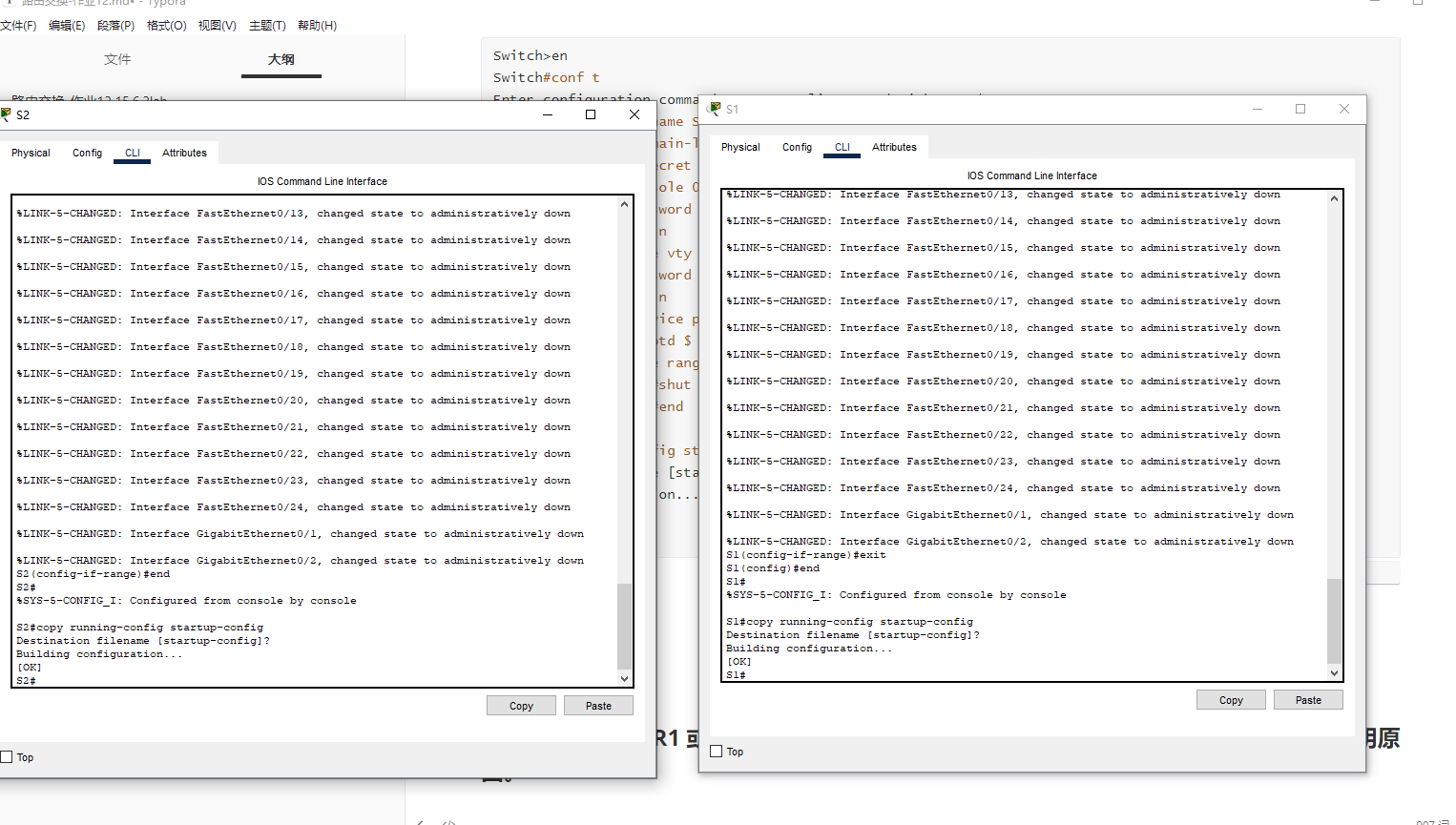
Q.0x13.i 这时在 R1 或 R2 上输入命令 show cdp neighbors 会看到一个空的列表。说明原因。
R1#show cdp neighbors
Capability Codes: R - Router, T - Trans Bridge, B - Source Route Bridge
S - Switch, H - Host, I - IGMP, r - Repeater, P - Phone
Device ID Local Intrfce Holdtme Capability Platform Port ID
R1#
R2#show cdp neighbors
Capability Codes: R - Router, T - Trans Bridge, B - Source Route Bridge
S - Switch, H - Host, I - IGMP, r - Repeater, P - Phone
Device ID Local Intrfce Holdtme Capability Platform Port ID
R2#
S2#show cdp neighbors
Capability Codes: R - Router, T - Trans Bridge, B - Source Route Bridge
S - Switch, H - Host, I - IGMP, r - Repeater, P - Phone
Device ID Local Intrfce Holdtme Capability Platform Port ID
S1 Fas 0/4 165 S 2960 Fas 0/4
S2#
S1#show cdp neighbors
Capability Codes: R - Router, T - Trans Bridge, B - Source Route Bridge
S - Switch, H - Host, I - IGMP, r - Repeater, P - Phone
Device ID Local Intrfce Holdtme Capability Platform Port ID
Switch Fas 0/4 17 S 2960 Fas 0/4
S2 Fas 0/4 137 S 2960 Fas 0/4
S1#R1 R2之间是空列表,因为链路是关闭的。所以没有相邻的相关邻居。
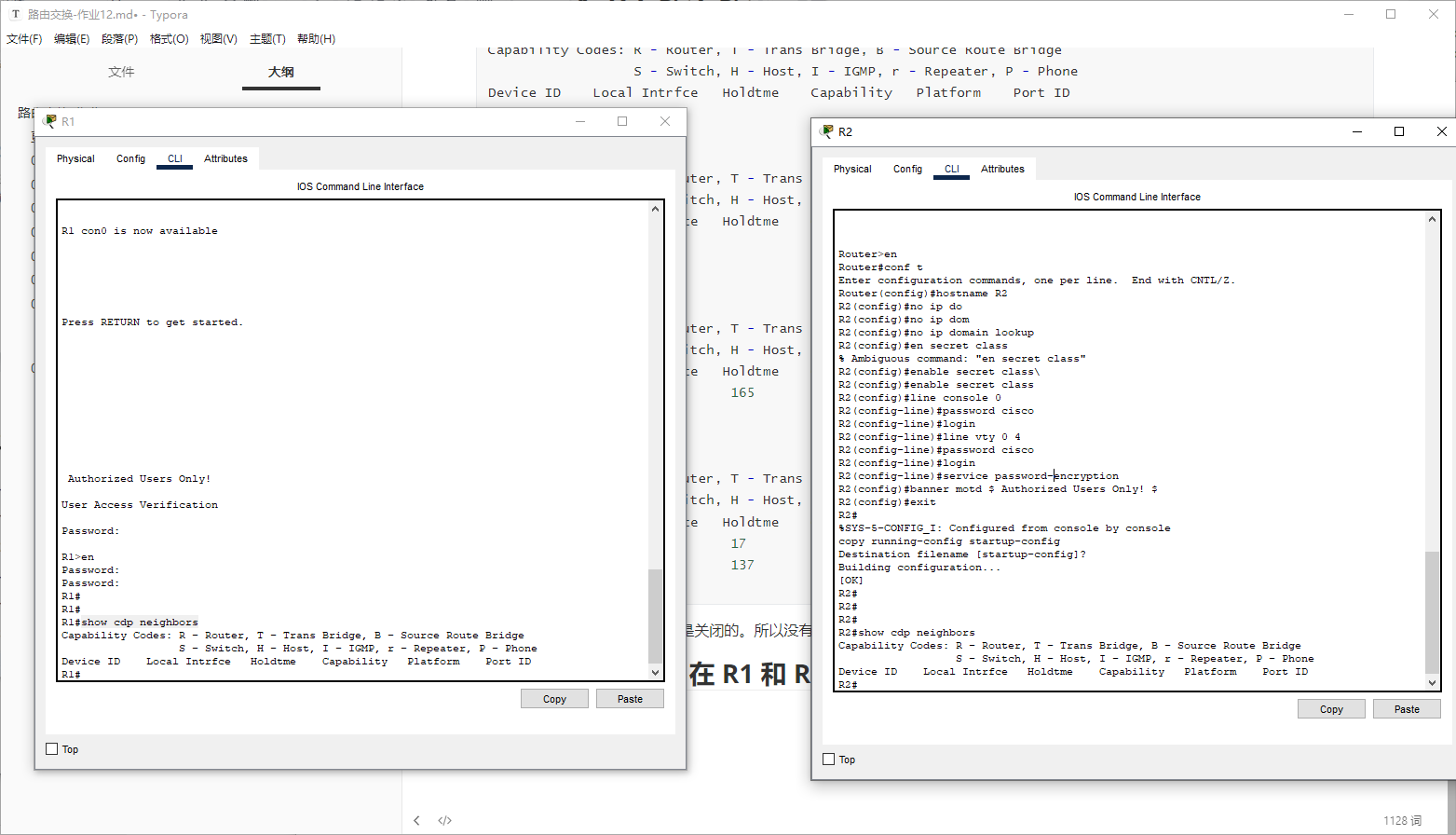
0x20 第 2 部分: 在 R1 和 R2 上配置并验证 IPv4 和 IPv6 地址
在第 2 部分中,您需要在 R1 和 R2 上配置并验证 IPv4 和 IPv6 地址。使用上表中包含的必要信息来完成这部 分的任务
0x21 步骤 1 : 给两台路由器配置 IP 地址。
a. 在两台路由器上启用 IPv6 单播路由。
b. 根据地址分配表给所有接口配置 IP 地址。
R1:
R1(config)#ipv6 unicast-routing
R1(config)#int g0/0/0
R1(config-if)#ip addr 172.16.1.1 255.255.255.0
R1(config-if)#ipv6 addr fe80::1 link-local
R1(config-if)#ipv6 addr 2001:db8:acad:2::1/64
R1(config-if)#no shut
R1(config)#int g0/0/1
R1(config-if)#ip addr 192.168.1.1 255.255.255.0
R1(config-if)#ipv6 addr fe80::1 link-local
R1(config-if)#ipv6 addr 2001:db8:acad:1::1/64
R1(config-if)#no shut
R1(config-if)#int lo1
R1(config-if)#ip addr 10.1.0.1 255.255.255.0
R1(config-if)#ipv6 addr fe80::1 link-local
R1(config-if)#ipv6 addr 2001:db8:acad:10::1/64
R1(config-if)#no shut
R1(config-if)#int lo2
R1(config-if)#ip addr 209.165.200.225 255.255.255.224
R1(config-if)#ipv6 addr fe80::1 link-local
R1(config-if)#ipv6 addr 2001:db8:acad:209::1/64
R1(config-if)#no shut
R1(config-if)#endR2:
R2#enable
R2#conf t
Enter configuration commands, one per line. End with CNTL/Z.
R2(config)#ipv6 unicast-routing
R2(config)#int g0/0/0
R2(config-if)#ip addr 172.16.1.2 255.255.255.0
R2(config-if)#ipv6 addr fe80::2 link-local
R2(config-if)#ipv6 addr 2001:db8:acad:2::2/64
R2(config-if)#no shut
R2(config-if)#int g0/0/1
R2(config-if)#ip addr 192.168.1.2 255.255.255.0
R2(config-if)#ipv6 addr fe80::2 link-local
R2(config-if)#ipv6 addr 2001:db8:acad:1::2/64
R2(config-if)#no shut
R2(config-if)#int lo1
R2(config-if)#ip addr 10.2.0.1 255.255.255.0
R2(config-if)#ipv6 addr fe80::2 link-local
R2(config-if)#ipv6 addr 2001:db8:acad:11::2/64
R2(config-if)#no shut
R2(config)#int lo2
R2(config-if)#ip addr 209.165.200.193 255.255.255.224
R2(config-if)#ipv6 addr fe80::2 link-local
R2(config-if)#ipv6 addr 2001:db8:acad:210::1/64
R2(config-if)#no shut
R2(config-if)#end0x22 验证地址:
R1:
R1#show ip int brief
Interface IP-Address OK? Method Status Protocol
GigabitEthernet0/0/0 172.16.1.1 YES manual up up
GigabitEthernet0/0/1 192.168.1.1 YES manual up up
Loopback1 10.1.0.1 YES manual up up
Loopback2 209.165.200.225 YES manual up up
Vlan1 unassigned YES unset administratively down down
R1#
R1#show ipv6 int brief
GigabitEthernet0/0/0 [up/up]
FE80::1
2001:DB8:ACAD:2::1
GigabitEthernet0/0/1 [up/up]
FE80::1
2001:DB8:ACAD:1::1
Loopback1 [up/up]
FE80::1
2001:DB8:ACAD:10::1
Loopback2 [up/up]
FE80::1
2001:DB8:ACAD:209::1
Vlan1 [administratively down/down]
unassigned
R1#R2:
R2#show ip int brief
Interface IP-Address OK? Method Status Protocol
GigabitEthernet0/0/0 172.16.1.2 YES manual up up
GigabitEthernet0/0/1 192.168.1.2 YES manual up up
Loopback1 10.2.0.1 YES manual up up
Loopback2 209.165.200.193 YES manual up up
Vlan1 unassigned YES unset administratively down down
R2#
R2#show ipv6 int brief
GigabitEthernet0/0/0 [up/up]
FE80::2
2001:DB8:ACAD:2::2
GigabitEthernet0/0/1 [up/up]
FE80::2
2001:DB8:ACAD:1::2
Loopback1 [up/up]
FE80::2
2001:DB8:ACAD:11::2
Loopback2 [up/up]
FE80::2
2001:DB8:ACAD:210::1
Vlan1 [administratively down/down]
unassigned
R2#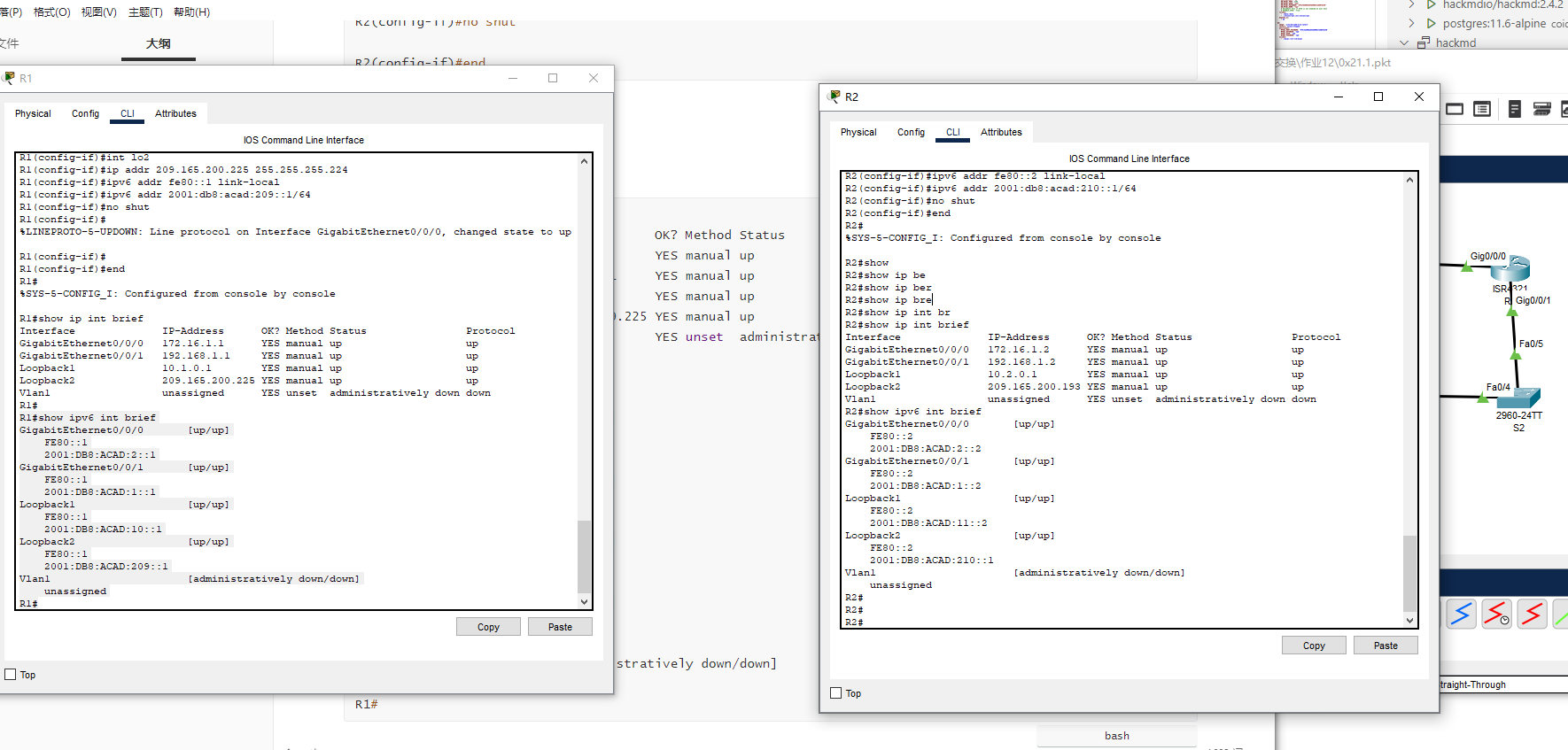
0x23 保存配置文件
R1:
R1#copy running-config startup-config
Destination filename [startup-config]?
Building configuration...R2:
R2#copy running-config startup-config
Destination filename [startup-config]?
Building configuration...
[OK]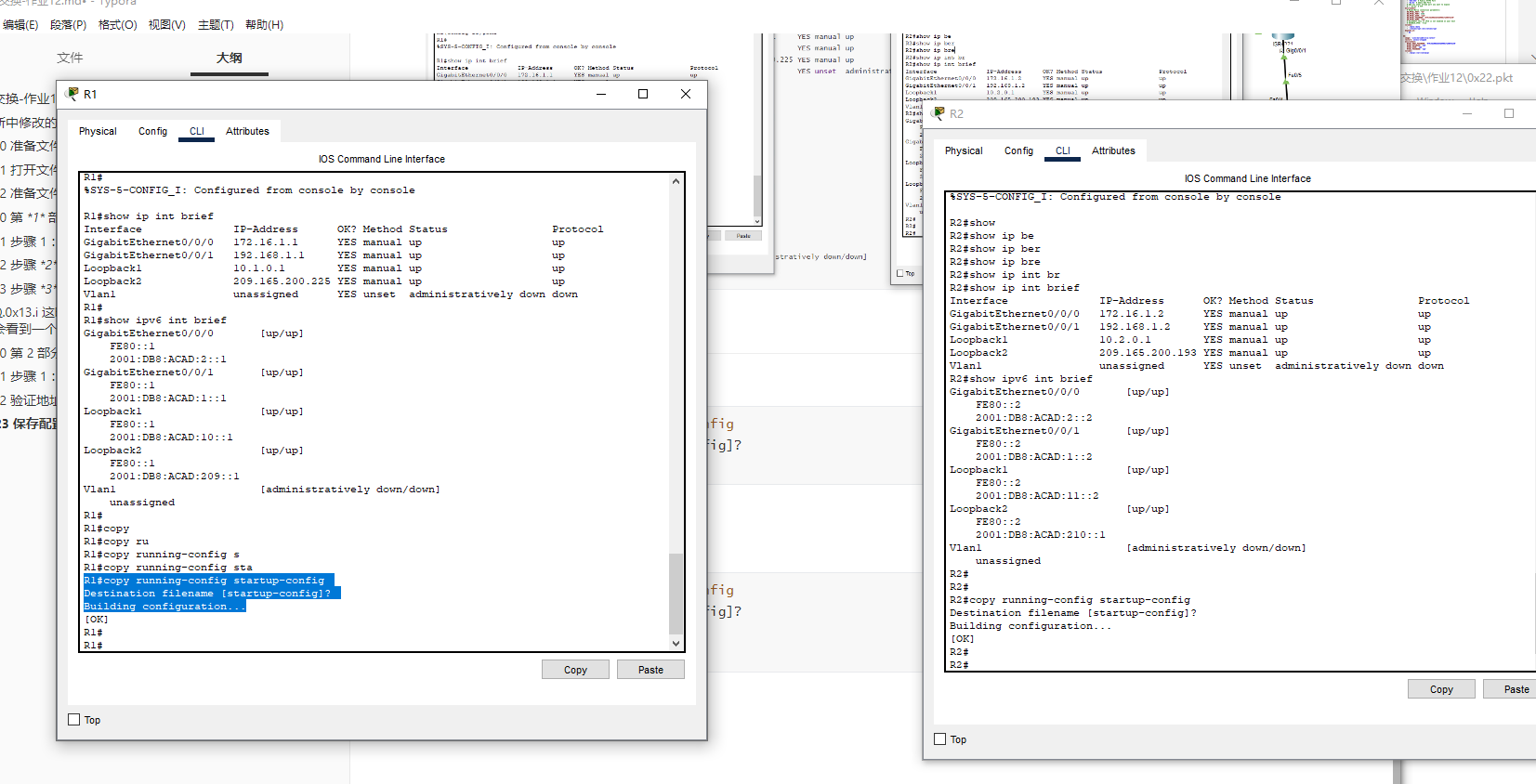
0x30 第 3 部分: 在 R1 和 R2 上配置并验证 IPv4 静态路由和默认路由
0x31 步骤 1 : 在 R1 上,使用 R2 G0/0/1 地址作为下一跳,配置一条去往 R2 Loopback1 网络的静态路由。
a. 使用 ping 命令来确认 R2 的 G0/0/1 接口是可达的。 b. 配置一条通过 R2 G0/0/1 地址到达 R2 Loopback1 网络的静态路由。
R1:
R1(config)#ip route 10.2.0.0 255.255.255.0 192.168.1.20x32 步骤 2 : 在 R1 上,配置一条通过 R2 G0/0/0 地址的静态默认路由
a. 使用 ping 命令来确认 R2 的 G0/0/0 接口是可达的。 b. 配置一条通过 R2 G0/0/0 地址的静态默认路由。
R2 G0/0/0端口IP:
| 设备 | 接口 | IP地址前缀 |
|---|---|---|
| R2 | G0/0/0 | 172.16.1.2 /24 |
R1(config)#end
R1#
%SYS-5-CONFIG_I: Configured from console by console
R1#ping 172.16.1.2
Type escape sequence to abort.
Sending 5, 100-byte ICMP Echos to 172.16.1.2, timeout is 2 seconds:
.!!!!
Success rate is 80 percent (4/5), round-trip min/avg/max = 0/0/0 ms
【成功ping通】配置默认静态路由:
R1(config)# ip route 0.0.0.0 0.0.0.0 172.16.1.20x33 步骤 3 : 在 R1 上,配置一条通过 R2 G0/0/1 地址的浮动静态默认路由。
配置一条通过 R2 G0/0/1 地址的浮动静态默认路由,将其 AD 设置为 80。
AD(Administrative Distance)设置为80。Administrative Distance是路由器用于选择最佳路径的度量标准,较低的AD值表示更可靠的路径。
R1(config)#ip route 0.0.0.0 0.0.0.0 192.168.1.2 800x34 步骤 4: 在 R2 上,配置一条通过 R1 G0/0/0 地址的静态默认路由
a. 使用 ping 命令来确认 R1 的 G0/0/0 接口是可达的。 b. 配置一条通过 R1 G0/0/0 地址的静态默认路由。
| 设备 | 接口 | \IP*** 地址*/****前缀 |
|---|---|---|
| R1 | G0/0/0 | 172.16.1.1 /24 |
密码:cisco
enable密码:class
R2#ping 172.16.1.1
Type escape sequence to abort.
Sending 5, 100-byte ICMP Echos to 172.16.1.1, timeout is 2 seconds:
!!!!!
Success rate is 100 percent (5/5), round-trip min/avg/max = 0/0/0 ms
R2#conf t
R2(config)#ip route 0.0.0.0 0.0.0.0 172.16.1.10x35 步骤 5: 验证这些路由是否正常工作
a. 使用 show ip route 命令确认路由器 R1 的路由表中出现了静态和默认路由。 b. 在 R1 上,输入命令 traceroute 10.2.0.1 。输出信息应该显示下一跳是 192.168.1.2。 c. 在 R1 上,输入命令 traceroute 209.165.200.193 。输出信息应该显示下一跳是 172.16.1.2。 d. 在 R1 G0/0/0 上输入 shutdown 命令。 e. 演示显示浮动静态路由正在正常工作。首先,输入 show ip route static 命令。您应该看到两条静态路 由。 AD 为 80 的默认静态路由和 AD 为 1 的静态路由(去往 10.2.0.0/24 网络) 。 f. 通过输入命令 traceroute 209.165.200.193 来证明浮动静态路由正在正常工作。traceroute 显示下一跳为 192.168.1.2。 g. 在 R1 G0/0/0 上输入 no shutdown 命令。
#a.
R1(config)#end
R1#show ip route
Codes: L - local, C - connected, S - static, R - RIP, M - mobile, B - BGP
D - EIGRP, EX - EIGRP external, O - OSPF, IA - OSPF inter area
N1 - OSPF NSSA external type 1, N2 - OSPF NSSA external type 2
E1 - OSPF external type 1, E2 - OSPF external type 2, E - EGP
i - IS-IS, L1 - IS-IS level-1, L2 - IS-IS level-2, ia - IS-IS inter area
* - candidate default, U - per-user static route, o - ODR
P - periodic downloaded static route
Gateway of last resort is 172.16.1.2 to network 0.0.0.0
10.0.0.0/8 is variably subnetted, 3 subnets, 2 masks
C 10.1.0.0/24 is directly connected, Loopback1
L 10.1.0.1/32 is directly connected, Loopback1
S 10.2.0.0/24 [1/0] via 192.168.1.2
172.16.0.0/16 is variably subnetted, 2 subnets, 2 masks
C 172.16.1.0/24 is directly connected, GigabitEthernet0/0/0
L 172.16.1.1/32 is directly connected, GigabitEthernet0/0/0
192.168.1.0/24 is variably subnetted, 2 subnets, 2 masks
C 192.168.1.0/24 is directly connected, GigabitEthernet0/0/1
L 192.168.1.1/32 is directly connected, GigabitEthernet0/0/1
209.165.200.0/24 is variably subnetted, 2 subnets, 2 masks
C 209.165.200.224/27 is directly connected, Loopback2
L 209.165.200.225/32 is directly connected, Loopback2
S* 0.0.0.0/0 [1/0] via 172.16.1.2
========================================
# b.
R1#traceroute 10.2.0.1
Type escape sequence to abort.
Tracing the route to 10.2.0.1
1 * 0 msec 0 msec
R1#traceroute 10.2.0.1
Type escape sequence to abort.
Tracing the route to 10.2.0.1
1 192.168.1.2 0 msec 0 msec 0 msec
R1#
========================================
#c.
R1#traceroute 209.165.200.193
Type escape sequence to abort.
Tracing the route to 209.165.200.193
1 172.16.1.2 0 msec 0 msec 0 msec
R1#
========================================
#d. 在 R1 G0/0/0 上输入 shutdown 命令。
R1#conf t
Enter configuration commands, one per line. End with CNTL/Z.
R1(config)#int g0/0/0
R1(config-if)#shut
R1(config-if)#end
#e.
R1#show ip route static
10.0.0.0/8 is variably subnetted, 3 subnets, 2 masks
S 10.2.0.0/24 [1/0] via 192.168.1.2
S* 0.0.0.0/0 [80/0] via 192.168.1.2
R1#
#f.
R1#traceroute 209.165.200.193
Type escape sequence to abort.
Tracing the route to 209.165.200.193
1 192.168.1.2 0 msec 0 msec 0 msec
R1#
#g.在 R1 G0/0/0 上输入 no shutdown 命令。
R1#conf t
Enter configuration commands, one per line. End with CNTL/Z.
R1(config)#int g0/0/0
R1(config-if)#no shut
R1(config-if)#end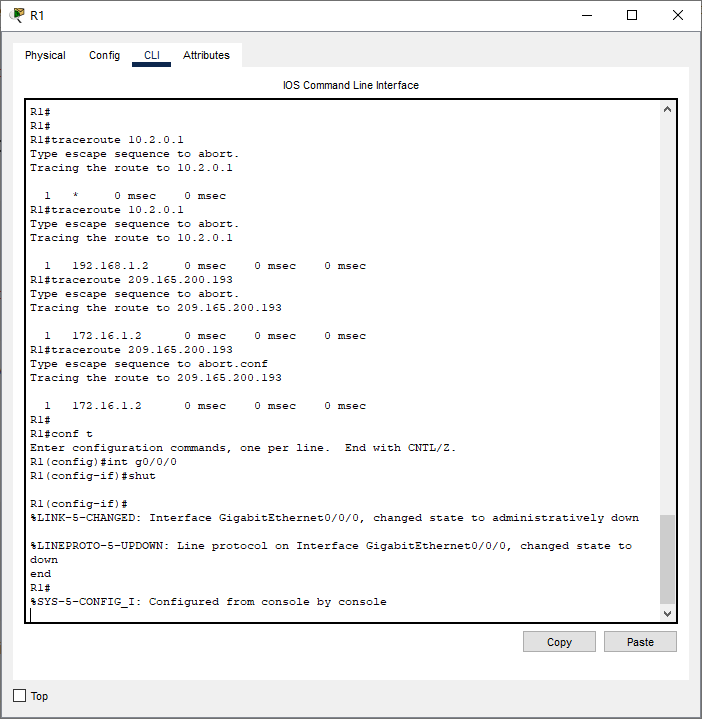
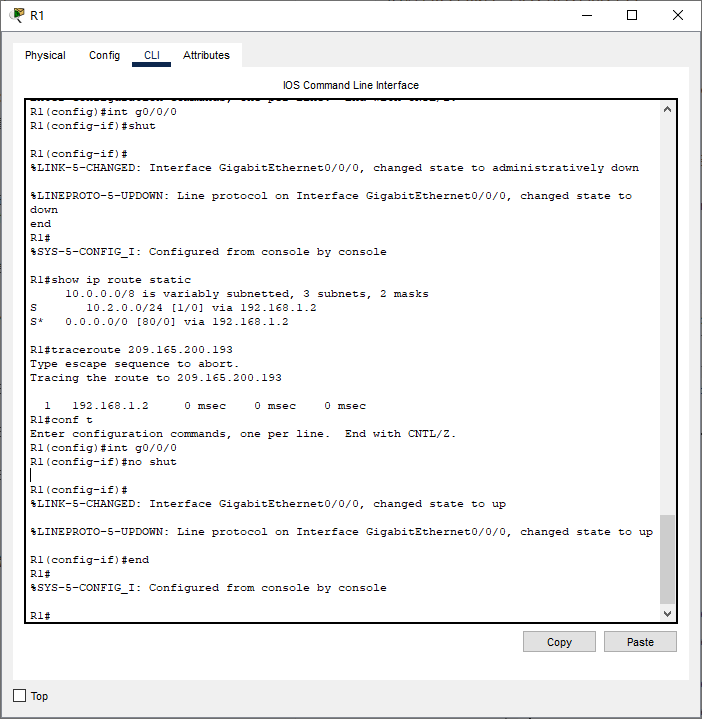
0x40 第 4 部分: 在 R1 和 R2 上配置并验证 IPv6 静态路由和默认路由
在第 4 部分中,您需要在 R1 和 R2 上配置静态路由和默认路由,让两台路由器之间能够使用 IPv6 建立完整的 连通性。再次强调,这里使用的静态路由代表不了这种网络环境中的最佳实践,只是为了评估您完成所需配置 的能力。
0x41 步骤 1 : 在 R2 上,使用 R1 G0/0/1 地址作为下一跳,配置一条去往 R1 Loopback1 网络的静态路由。
打开配置窗口 a. 使用 ping 命令来确认 R1 的 G0/0/1 接口是可达的。 b. 配置一条通过 R1 G0/0/1 地址到达 R1 Loopback1 网络的静态路由。
R2 G0/0/1端口IP:
| 设备 | 接口 | IP地址前缀 |
|---|---|---|
| R2 | G0/0/1 | 192.168.1.2 /24 |
R2:
R2#ping 192.168.1.2
Type escape sequence to abort.
Sending 5, 100-byte ICMP Echos to 192.168.1.2, timeout is 2 seconds:
!!!!!
Success rate is 100 percent (5/5), round-trip min/avg/max = 0/2/5 ms
R2(config)#ipv6 route 2001:db8:acad:10::/64 2001:db8:acad:1::1
0x42 步骤 2 : 在 R2 上,配置一条通过 R1 G0/0/0 地址的静态默认路由
a. 使用 ping 命令来确认 R1 的 G0/0/0 接口是可达的。 b. 配置一条通过 R1 G0/0/0 地址的静态默认路由。
| 设备 | 接口 | \IP*** 地址*/****前缀 |
|---|---|---|
| R1 | G0/0/0 | 172.16.1.1 /24 |
R1#ping 172.16.1.1
R2#ping 172.16.1.1
Type escape sequence to abort.
Sending 5, 100-byte ICMP Echos to 172.16.1.1, timeout is 2 seconds:
!!!!!
Success rate is 100 percent (5/5), round-trip min/avg/max = 0/0/0 ms
R2#conf t
Enter configuration commands, one per line. End with CNTL/Z.
R2(config)# ipv6 route ::/0 2001:db8:acad:2::1
0x43 步骤 3 : 在 R2 上,配置一条通过 R1 G0/0/1 地址的浮动静态默认路由
配置一条通过 R2 G0/0/1 地址的浮动静态默认路由,将其 AD 设置为 80。
R2:
R2(config)#ipv6 route ::/0 2001:db8:acad:1::1 80
0x44 步骤 4: 在 R1 上,配置一条通过 R1 G0/0/0 地址的静态默认路由
a. 使用 ping 命令来确认 R2 的 G0/0/0 接口是可达的。 b. 配置一条通过 R2 G0/0/0 地址的静态默认路由。
R2 G0/0/0端口IP:
| 设备 | 接口 | IP地址前缀 |
|---|---|---|
| R2 | G0/0/0 | 172.16.1.2 /24 |
R1:
R1#ping 172.16.1.2
Type escape sequence to abort.
Sending 5, 100-byte ICMP Echos to 172.16.1.2, timeout is 2 seconds:
!!!!!
Success rate is 100 percent (5/5), round-trip min/avg/max = 0/0/0 ms
R1#conf t
Enter configuration commands, one per line. End with CNTL/Z.
R1(config)#ipv6 route ::/0 2001:db8:acad:2::2

0x45 步骤 5: 验证这条路由正在正常工作
a. 使用 show ipv6 route 命令确认路由器 R2 的路由表中出现了静态和默认路由。 b. 在 R2 上,输入命令 traceroute 2001:db8:acad:10::1。输出信息应该显示下一跳是 traceroute 2001:db8:acad:1::1。 c. 在 R1 上,输入命令 traceroute 2001:db8:acad:209::1。输出信息应该显示下一跳是 2001:db8:acad:2::1。 d. 在 R2 G0/0/0 上输入 shutdown 命令。 e. 演示显示浮动静态路由正在正常工作。首先,输入 show ipv6 route static 命令。您应该看到两条静态路 由。 AD 为 80 的默认静态路由和 AD 为 1 的静态路由(去往 2001:db8:acad:10::/64 网络)。 f. 最后,通过输入命令 traceroute 2001:db8:acad:209::1 来证明浮动静态路由正在正常工作。traceroute 显 示下一跳为 2001:db8:acad:1::1。
#a.
R2#show ipv6 route
IPv6 Routing Table - 11 entries
Codes: C - Connected, L - Local, S - Static, R - RIP, B - BGP
U - Per-user Static route, M - MIPv6
I1 - ISIS L1, I2 - ISIS L2, IA - ISIS interarea, IS - ISIS summary
ND - ND Default, NDp - ND Prefix, DCE - Destination, NDr - Redirect
O - OSPF intra, OI - OSPF inter, OE1 - OSPF ext 1, OE2 - OSPF ext 2
ON1 - OSPF NSSA ext 1, ON2 - OSPF NSSA ext 2
D - EIGRP, EX - EIGRP external
S ::/0 [1/0]
via 2001:DB8:ACAD:2::1
C 2001:DB8:ACAD:1::/64 [0/0]
via GigabitEthernet0/0/1, directly connected
L 2001:DB8:ACAD:1::2/128 [0/0]
via GigabitEthernet0/0/1, receive
C 2001:DB8:ACAD:2::/64 [0/0]
via GigabitEthernet0/0/0, directly connected
L 2001:DB8:ACAD:2::2/128 [0/0]
via GigabitEthernet0/0/0, receive
S 2001:DB8:ACAD:10::/64 [1/0]
via 2001:DB8:ACAD:1::1
C 2001:DB8:ACAD:11::/64 [0/0]
via Loopback1, directly connected
L 2001:DB8:ACAD:11::2/128 [0/0]
via Loopback1, receive
C 2001:DB8:ACAD:210::/64 [0/0]
via Loopback2, directly connected
L 2001:DB8:ACAD:210::1/128 [0/0]
via Loopback2, receive
L FF00::/8 [0/0]
via Null0, receive
#b
R2#traceroute 2001:db8:acad:10::1
Type escape sequence to abort.
Tracing the route to 2001:db8:acad:10::1
1 2001:DB8:ACAD:1::1 0 msec 0 msec 0 msec
#c
R2#traceroute 2001:db8:acad:209::1
Type escape sequence to abort.
Tracing the route to 2001:db8:acad:209::1
1 2001:DB8:ACAD:2::1 0 msec 0 msec 0 msec
R2#
#d
R2#conf t
Enter configuration commands, one per line. End with CNTL/Z.
R2(config)#int g0/0/0
R2(config-if)#shut
R2(config-if)#end
#e:
R2#show ipv6 route
IPv6 Routing Table - 9 entries
Codes: C - Connected, L - Local, S - Static, R - RIP, B - BGP
U - Per-user Static route, M - MIPv6
I1 - ISIS L1, I2 - ISIS L2, IA - ISIS interarea, IS - ISIS summary
ND - ND Default, NDp - ND Prefix, DCE - Destination, NDr - Redirect
O - OSPF intra, OI - OSPF inter, OE1 - OSPF ext 1, OE2 - OSPF ext 2
ON1 - OSPF NSSA ext 1, ON2 - OSPF NSSA ext 2
D - EIGRP, EX - EIGRP external
S ::/0 [80/0]
via 2001:DB8:ACAD:1::1
C 2001:DB8:ACAD:1::/64 [0/0]
via GigabitEthernet0/0/1, directly connected
L 2001:DB8:ACAD:1::2/128 [0/0]
via GigabitEthernet0/0/1, receive
S 2001:DB8:ACAD:10::/64 [1/0]
via 2001:DB8:ACAD:1::1
C 2001:DB8:ACAD:11::/64 [0/0]
via Loopback1, directly connected
L 2001:DB8:ACAD:11::2/128 [0/0]
via Loopback1, receive
C 2001:DB8:ACAD:210::/64 [0/0]
via Loopback2, directly connected
L 2001:DB8:ACAD:210::1/128 [0/0]
via Loopback2, receive
L FF00::/8 [0/0]
via Null0, receive
其中:
S ::/0 [80/0]
via 2001:DB8:ACAD:1::1
S 2001:DB8:ACAD:10::/64 [1/0]
via 2001:DB8:ACAD:1::1
是静态路由信息
## f
R2#traceroute 2001:db8:acad:209::1
Type escape sequence to abort.
Tracing the route to 2001:db8:acad:209::1
1 2001:DB8:ACAD:1::1 0 msec 0 msec 0 msec
R2#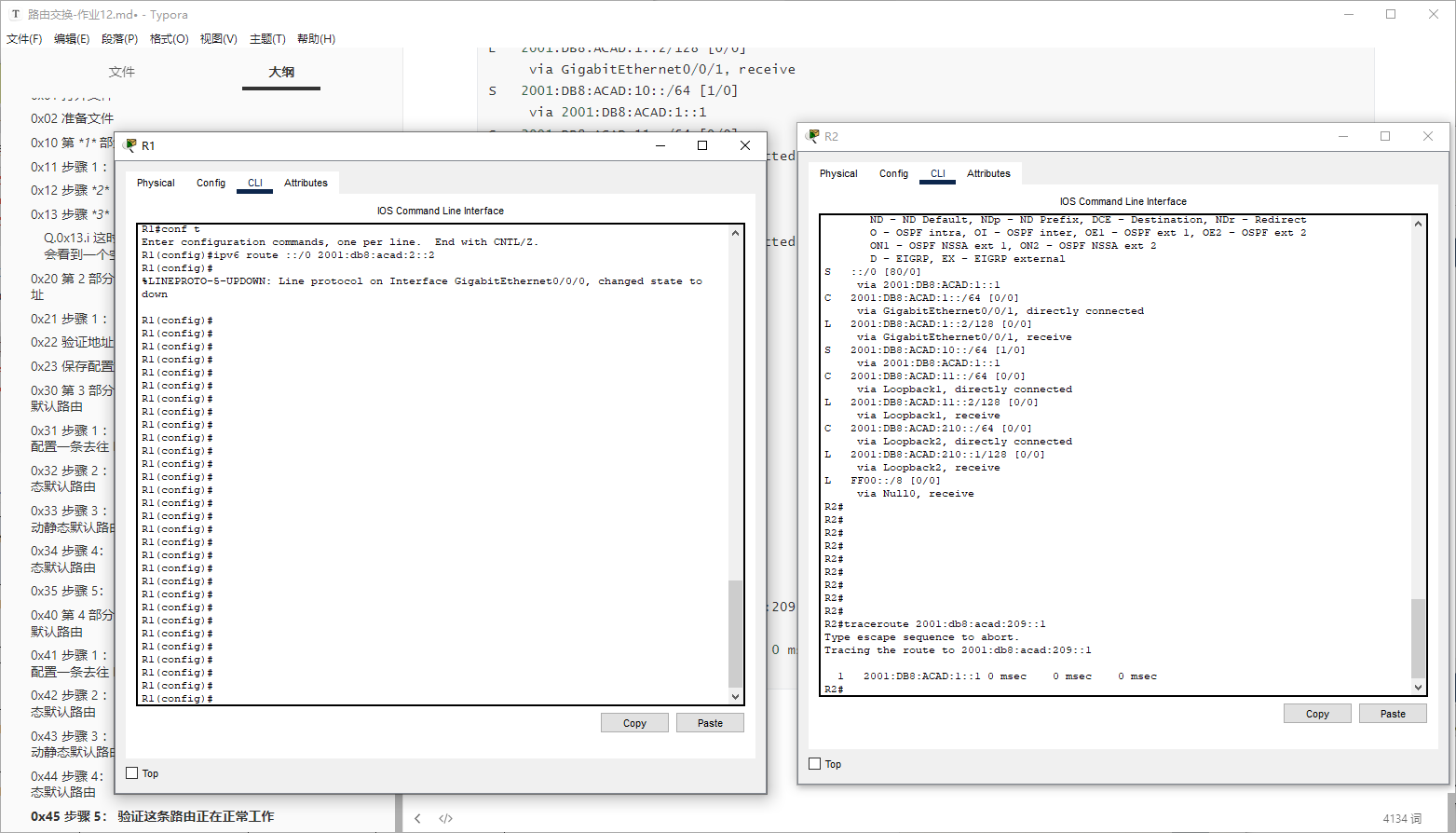
0x50 文件下载
-
分步骤文件:

下载地址:https://p.dabbit.net/blog/pic_bed/2023/06/7eec12871b2df5bb_202306131923224.rar

发表回复